Ford is more interested in seeking broad protection of the ideas around autonomous serving in a law enforcement function, rather than specific mechanical details own the technology.
Despite the numerous claims from experts that fully autonomous cars will make the roads much safer, Ford is arguing in this application that traffic violations will not be completely eradicated. Even though driverless vehicles will be programmed to obey traffic laws, a human can override that programming to operate the vehicle at any time, opening up the possibility of violations of those laws, bringing the need for policing traffic.
Ford says that human police officers won’t be replaced – they will be able to instead focus on those tasks that can’t be automated as they wouldn’t be required to be inside the car. Meanwhile, the automated car will be able to use AI to locate a parking spot to remain inconspicuous to catch lawbreakers, fitted with sensors and cameras to track their license plates.
The application has not yet been scrutinised by the US PTO. The claims of the patent may need to be narrowed down and further defined before it is granted.


.jpg)
.jpg)
.jpg)

.jpg)

.jpg)


.jpg)